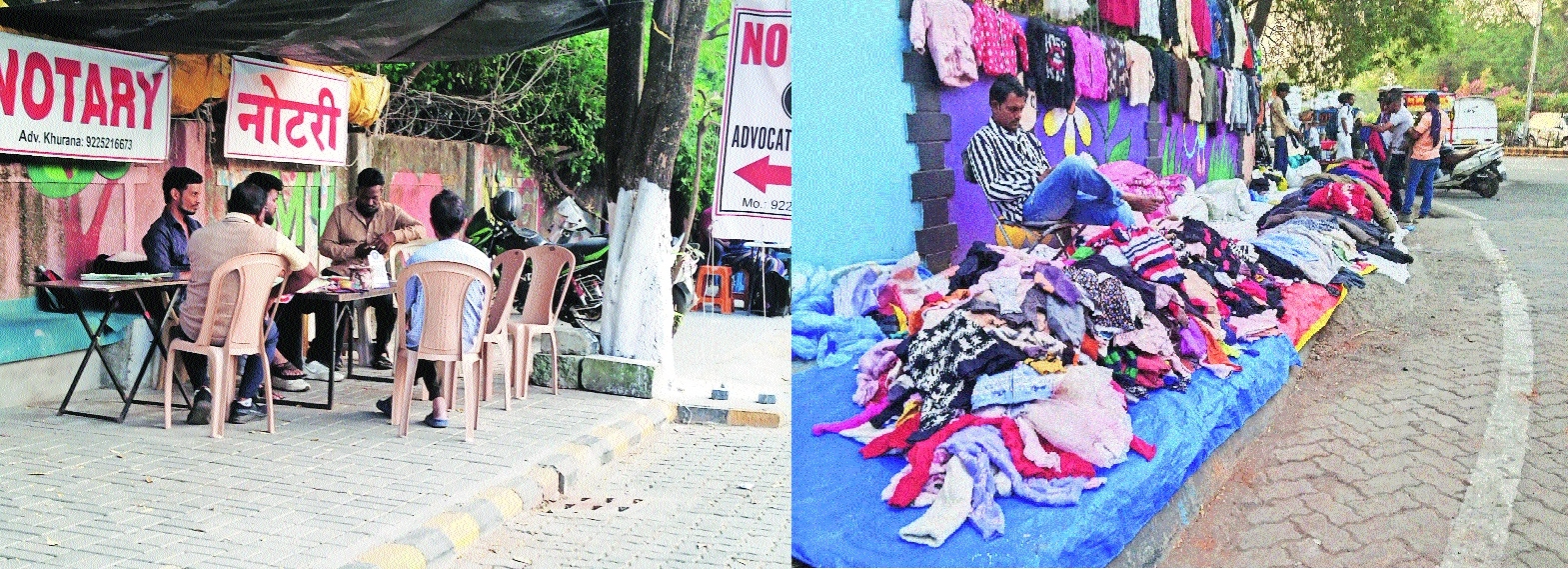Encroachment on footpaths threatening pedestrian spaces
| Date :29-Nov-2024 |

By Kunaal Badge :
Nagpur is one of the biggest industrial, medical, and educational hubs of Central India and it is growing rapidly. With its growth, population of city, number of people visiting the city, and number of vehicles on roads are also increasing. This increase is causing shrinking of pedestrian spaces in the city.
The pedestrians are struggling to find space to walk on in the city as their spaces are being encroached everywhere. The pedestrian spaces such as footpaths, road crossings, refuge islands and others in the city are shrinking rapidly with every passing day. The number of roads with footpaths is inadequate in the city. The available footpaths are plagued by encroachment of various kinds that makes them useless for pedestrians.
Kajal Chalurkar, a resident of Sadar, said, “Footpaths in city are often occupied either by roadside shopkeepers, parked vehicles or by walkways that are broken. Side of footpath which forms the shoulder of the road, is often occupied by parked bikes. It leaves only the road to walk on. During peak hours, we have to walk on roads clogged with traffic.
The condition has gone from bad to worse.”
The city planners in the past had designed wide roads with spacious footpaths for pedestrians. These footpaths are now seen encroached by roadside shop owners who keep their goods and banners on the footpath. The footpaths are also seen occupied by building materials and often used as parking spots by bikes in stretches of road having no parking spaces. Increasing number of vehicles in the city has also forced widening of roads, often at the cost of roadside footpaths, which have been narrowed or removed completely. Various ongoing developmental works in the city are also impacting the pedestrian spaces in the city.
The road and footpath design comes under urban design of the city. Sujit Rodge, Architect, and Chairman, Maharashtra regional chapter, Institute of Town Planner, India (ITPI) told ‘The Hitavada’, “In the city, not even a single Square is ideally designed which affect the pedestrian traffic. Absence of foot over bridge (FOB) or underpasses force the pedestrian to cross the road through heavy traffic.”
He also pointed out the need of considering footpaths while converting old tar roads into concrete roads. He said, “The entire cross section of the road including footpaths should be designed while converting tar roads into concrete roads.”
Rodge gave the example of stretch between Kriplani Square and Ajni Square as one of the better pedestrian friendly roads in the city.
Sujit Rodge also emphasised the importance of street furniture for smooth flow of pedestrian traffic.The street lights, direction boards, traffic lights, traffic signs, bus stops, post boxes and other street furniture that is installed by civic authorities should also be installed keeping in mind the pedestrian traffic instead of asthetic beauty of the road. The infrastructure for CCTV cameras installed in the city, street lights and other street furniture has become obstruction for pedestrians due to their inaccurate positioning in some part of city.
Another thing that Rodge brought to notice is the increasing plinth heights of newly construted buildings for a fear of rain water entering the houses.
This raised plinth needs a ramp, which usually extends up to footpaths, encroaching the pedestrian space.
The footpaths are also seen encroached by goods and display boards of the adjacent shopowner. Even though the authorities take action against illegal encroachment many a time by confiscating the material on footpaths, the encroaches return a few days later and the condition returns to square one. “We have proposed to set up a hawkers’ zone where all the roadside hawkers will be shifted, but its implementation has been affected by various court cases,” said Sanjay Kamble, Assistant Superintendent, Encroachment Department of Nagpur Municipal Corporation (NMC) while speaking to ‘The Hitavada’.
The tall medians in the city without any alternative path to cross the road have also made life difficult for pedestrains. A pedestrian has to walk all the way upto the next square to cross the road by wading his/her way through oncoming traffic.
The problem is more prominent on roads with new Metro routes where the height of medians have divided the city in two parts.
Paramjit Singh Ahuja, renowned Architect from the city, suggested giving pedestrian crossings in the medians with proper signals. He, however, blamed the road design biased towards motorised transport for the shrinking spaces for non-motorised traffic consisting of Predastrians, cyclist, carts, and people with wheel chairs among others. He explained, “Road design is heavily tilted in favour of motorised transport.The roads not only have big carriageways for motorised transport, but also these carriageways are well lit. The pedastrian paths, however, are not so well lit.”
Ahuja emphasised the designs can not be changed on existing roads but the roads being built in new localities around the city areas that are yet to be developed, should be designed by keeping non-motorised traffic in mind. Also, the enforcement of traffic rules by authorities, and following those rules are also equally important. “By designing pedestrian-friendly roads, educating the citizens, and enforcing the traffic rules, it is possible to make city traffic pedastrian friendly,” he stated.
Even though, it is hard to solve the issue in a single swipe, some small steps can be hugely fruitful for the future. Sujit Rodge suggests conducting a detailed study of all Squares and finding the optimal solution to better the pedestrian and vehicular traffic. “It is impossible to make changes in cross sections of old roads, but new roads should be made keeping in mind the pedestrian traffic. In a construction of a road achieving the function should be priorotised instead of asthetic part of the road,” he concluded.